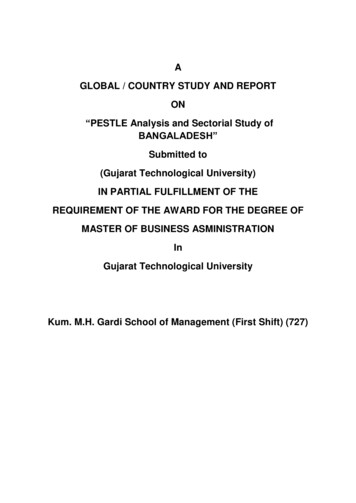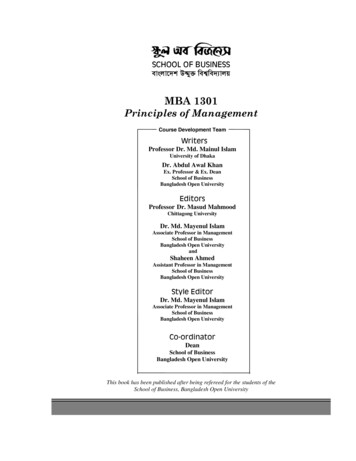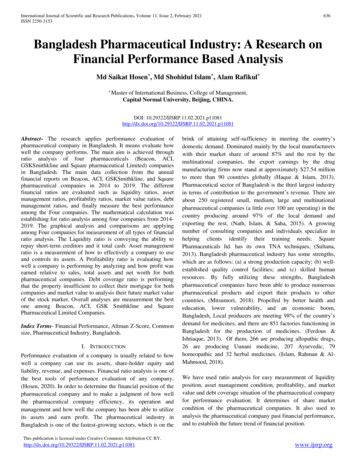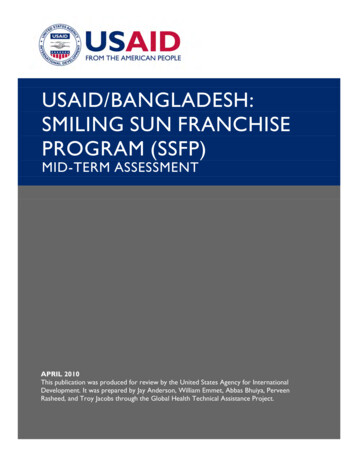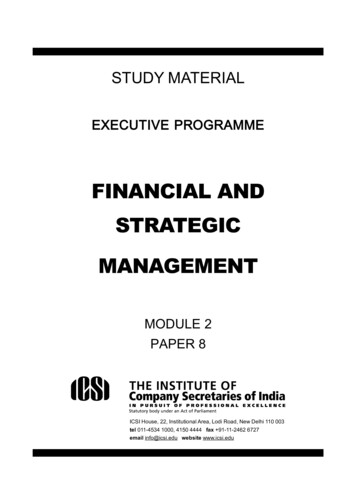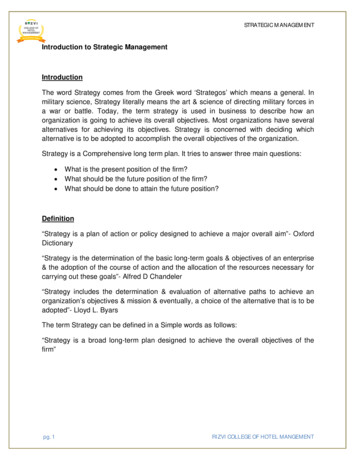
Transcription
Commonwealth of Learning Executive MBA/MPASC3 Strategic ManagementCourse Introduction
Course Author:Dr. Robin W. SmithTeaching FellowGraduate School of BusinessCollege of BusinessMassey UniversityPalmerston North, New ZealandCourse Designer/Editor:Shari Virjee, BA, GD IM (Post-GraduateDiploma in International Management)Vancouver, CanadaCopyright Commonwealth of Learning, 2003All rights reserved. No part of this course may be reproduced in any form by any meanswithout prior permission in writing from:The Commonwealth of Learning1285 West BroadwaySuite 600Vancouver, BC V6H 3X8CANADAe-mail: info@col.orgSC3 Strategic Management, Course Introductionpage ii
Contents1234Welcome to SC3 Strategic Management . 1About the Course Author. 1Tutor Contact Information . 2Course Introduction . 24.1Course Overview, Objectives and Outcomes . 24.1.1Overview . 24.1.2Objectives . 24.1.3Outcomes. 34.2Navigating through SC3 . 34.2.1Questions for Consideration . 34.2.2Activities . 44.2.3Optional Online Readings & Terms . 45Assessment Scheme . 45.1Assignment Formats . 55.1.1Essay . 65.1.2Investigative Report . 65.2Final Examination . 75.3Ask Your Tutor . 86Supplementing Your Course Readings . 86.0.1Illustrative Reading. 86.0.2Supplementary Academic Readings. 86.0.3Library Databases . 107Some Helpful Notes . 127.1Final Exam . 127.2Plagiarism . 127.3Suggestions for presentation of written work . 12SC3 Strategic Management, Course Introductionpage iii
SC3 Strategic Management, Course Introductionpage iv
1Welcome to SC3 Strategic ManagementThis course, SC3 Strategic Management, exists to provide you with knowledge of theconcepts and language of strategic management and planning. This involves those aspectsof organisational behaviour, development, and environmental change most concernedwith the long term survival and growth of the organisation.The course consists of eight study Blocks:Block 1: Introduction to Strategic ManagementBlock 2: Managing the Strategy CycleBlock 3: The Strategy EquationBlock 4: The Strategy LandscapeBlock 5: Organisational AnalysisBlock 6: Strategic Analysis and ChoiceBlock 7: Industry Environment and Strategic ChoiceBlock 8: Implementing Strategy and Strategic Control Processes2About the Course AuthorRobin W. N. Smith, B. Econ Hons. (Queensland), MBA, PhD (MNZITT, MNZIM).Any biases in text content may be attributed to the personal background and experiencesof the course author. Here is a short bio on Dr. Robin Smith, course author for SC3.Born and educated in Australia, the course author spent much of his early career in theSouth Pacific, especially Fiji, as a secondary school teacher. From the 1960s till early1970s he served as Manager of the Fijian Association and General Secretary of theAlliance Party during and after Fiji’s transition to independence. Apart from the directlypolitical aspects of this work, his focus of responsibilities was on community and ruraldevelopment planning and strategy. He left in the mid 1970s to undertake and completean MBA and PhD at Massey University, New Zealand.For the last two decades, Dr. Smith has led research on and taught the post-graduate levelcourses on Business Policy/ Strategic Management in the College of Business at MasseyUniversity. He is a Senior Lecturer in the Department of Management and a Fellow of theGraduate School of Business, teaching in the area of advanced strategy for the MasseyExecutive MBA.SC3 Strategic Management, Course Introductionpage 1 of 13
Dr. Smith has consulted and taught widely in Asia, namely UNESCAP (Bangkok) andAPEC (Singapore), the South Pacific (Fiji Public Service Commission, Cook Islandssmall business skills) as well as within New Zealand (territorial authorities, governmentdepartments and private associations and small and medium sized businesses).3Tutor Contact InformationPlease use the following contacts if you have course related enquiries.Course Tutor (Name):Mail:Phone:Fax:E-mail:4Course IntroductionThis course, SC3 Strategic Management has been designed as part of the Commonwealthof Learning CEMBA/CEMPA Programme, as one of two specialist compulsory coursesfor students pursuing the CEMBA. As a 6-credit, 120 hour course offered by distance, thecourse is meant to be taken primarily as independent study, with limited face-to-face timewith Tutor and other classmates (approximately 10 hours).4.1Course Overview, Objectives and Outcomes4.1.1OverviewThis course examines the nature of strategic decision making in organisations and thosefactors that influence the process. The systems and techniques of strategic management,planning, and decision-making are examined in the context of the business organisation.4.1.2Objectivesa. To develop an understanding of the nature of strategy, both as an area ofknowledge and as a characteristic of the growth and development processes oforganisations and environments.b. To develop an understanding of strategy formulation and implementationprocesses.SC3 Strategic Management, Course Introductionpage 2 of 13
c. To relate (a) and (b) above to the process of organisational planning.The focus in this paper is on the development in the student of holistic thinking and anunderstanding of the evolution, operation and survival of complete organisationalsystems.4.1.3OutcomesAt the end of this course, you should have: an understanding of the terms, concepts and language of strategy developed an overview perspective on the organisation and in particular the ways inwhich strategic management and planning processes, systems and behaviours areexpressed acquired strategic thinking skills and abilities an awareness and understanding of selected tools and techniques used in the strategicmanagement process.4.2Navigating through SC3Two types of student exercises support this course of studies: Questions for Consideration Activities.You will encounter at least one set of Questions for Consideration and/or one Activity perBlock.4.2.1Questions for ConsiderationThe Questions for Consideration have been designed to encourage the student to think indepth about the content of the course and the diversity and variety in the subject matter.In BLOCK 1 the questions are simply listed for consideration. In the remainder of theBLOCKS, the questions are positioned alongside a propositional statement designed toprovide a background and a context within which the student should seek to develop theiranswer. This helps to focus the student’s attention within a defined context and requiresthem to analyse and interpret the problem or issues from this perspective. This adds totheir thinking discipline and has the effect of building their critical faculties. The bulk ofthe questions have been developed for the first four Blocks, which constitute the largestproportion of the curriculum.The questions themselves provide a means for students to both acquire skills of analysis,and to gain practice in developing answers that will assist them in their preparation forSC3 Strategic Management, Course Introductionpage 3 of 13
the final exam. To acquire these benefits it is necessary, therefore, that they attempt asufficient selection from the range provided.Note: Your Tutor may identify, prior to the start of the course, a short list of questionsthat students will be expected to prepare for discussion during the face-to-face contacttime with the Tutor. This will give you the chance to prepare your arguments and developmaterial for further analysis within the context of a specified tutorial session.4.2.2ActivitiesThe second component is built around a range of Activities designed to involve thestudent in desk and/or field research. Each activity focuses on an aspect of strategicmanagement and if properly carried out, will help to develop in the student a greaterknowledge of real world strategic activity as well as the connections that exist betweenconcept and practice.Through these exercises, students should be able to develop material that will serve toillustrate their exam answers and through which they may demonstrate theirunderstanding of the links between theory and practice.4.2.3Optional Online Readings & TermsThe occasional online reading appearing in the text is considered Optional and has beenprovided for those students wishing to read further on a specific topic. The onlinelocation of these readings are referred to as ‘Web Links’; in order to access theselocations (on the World Wide Web), students would require connection to the Internet.5Assessment SchemeYou are required to submit four Assignments based on Activities within the Block text,for a total of 30% of the total grade for the course. The first two Assignments relate toBlock 1, and carry a lesser percentage weighting; this gives you a chance to becomefamiliar with the Tutor’s marking scheme before attempting Assignments Three andFour, which carry a heavier weighting and a specific format. A Final Exam worth 70% isto be administered at the end of the course.The below scheme provides details of the Assignments, and also suggests a timeline(based on completion of Blocks) for submission of these requirements.SC3 Strategic Management, Course Introductionpage 4 of 13
BlockDescription of ActivityAssessment weightingBlock 1Assignment One: Defining Strategy A & B5%Assignment Two: Activity (student selected)5%Block 2Block 3Block 4Assignment Three (student selected from across these three Blocks)10%Block 5Block 6Block 7Block 8Assignment Four (student selected from across these four Blocks)10%Final Exam70%TOTAL100%5.1Assignment FormatsYou are assessed in a variety of ways. You are expected to establish and maintainperformance across all assessment areas. The mix of assessment has been designed tomeasure the clarity of your understanding of course concepts as well as your ability toapply these to practice. The written assignments are focused on the conceptual as well asthe practical.*See Section 5.2 for more details on the Final Exam.Below are two suggested formats for Assignments. They are intended primarily as aguide for students as they complete Assignments Three and Four, as well as that forTutors as they evaluate students’ submitted work. Tutors are to have prepared a ‘CourseAssessment Information Sheet’ with specific Assignment details.SC3 Strategic Management, Course Introductionpage 5 of 13
5.1.1EssayTitle: EssayDue Date:Weighting:10% of total gradePurpose:To develop an understanding of the concepts and models of strategicmanagement.Format:You are expected to provide a thoughtful and well-thought response to oneof the following questions:Q1. Q2 .Note: Your Tutor may select 2-3 options from the Questions for Considerationincluded in the BLOCKS (Classroom Discussion and Debate style), or alternatively, fromthose questions in the Test Bank.5.1.2Investigative ReportTitle: Investigative ReportDue Date:Weighting:10% of total gradePurpose:To encourage an understanding of the actual nature of a strategiccondition, circumstance, or event in an organisation and itsenvironment.Format:You are expected to prepare and present a ‘strategy investigation’assignment as directed by the Tutor. This will follow the instructions andformat as set out below. The Format in particular will help you toassemble your ideas and organise your thoughts into a consistent whole.Note: Your Tutor may select 1-2 options from the list of Activities as set out in thevarious BLOCKS. These Activities should be pre-selected and included in the ‘CourseAssessment Information Sheet’ (see section 5.3) so that the student is aware of theassignment details and the form of assessment from the start of their studies. Theinstructions may also include a specific Format to use when undertaking the assignment.SC3 Strategic Management, Course Introductionpage 6 of 13
5.2Final ExaminationThe final exam consists of three parts – Parts A, B, and C. The rationale for this is set outbelow:Part A consists of Multiple Choice questions designed to test and probe a student’sunderstanding of concepts used in the course. Most especially they are configured tochallenge a student to discriminate between similar meanings and choices. The examinercan adjust the level of difficulty by using differing degrees of ambiguity in the optionsprovided.Part B requires students to extend their understanding of course concepts and definitionsto a further level, and be able to illustrate their understanding through example. Thesequestions may be drawn from the Test Bank (supplied with the course). The answersshould be in an essay type format and kept to around 3-400 words (or 1-2 pages). Thequestions are designed to require the student to explain the content and relevance of aparticular idea or concept and relate it to a given example drawn from their ownexperience or from information gained from the course. This is most important, asprovision of relevant examples and illustrations will serve to demonstrate the student’sunderstanding of the application or expression of the concept in practice.In Part C the student should expect questions on the broader strategic issues andconditions facing all organisational types (business, not-for-profit, public and privatesector, etc.) and their implications and consequences for the discipline of strategicmanagement and planning as a whole. They should focus on current events and businesspractices and conditions. This ensures that the students develop an awareness andunderstanding of present conditions and circumstances and to do this, they need toengage in effective reading. The questions could be expected to cover various aspects ofthe following key themes: The evolution and changes that have occurred in recent years to industry andsocietal landscapes in (Country, District, Region, etc. of choice); The components of such landscapes and the various ways in which they can beanalysed for strategic management and planning purposes; The composition and construction of organisations and an understanding of thestrategic processes and conditions at work within them; The place, role and effectiveness of selected tools and models used in theanalysis of such landscapes and such organisations; Significant shifts in strategic thinking and perspective (e.g., such as those thathave accompanied the contemporary emphasis on performance Outcomes andwell as Outputs when assessing the effectiveness of the implementation side ofthe strategic planning cycle).SC3 Strategic Management, Course Introductionpage 7 of 13
5.3Ask Your TutorIf you did not receive it with your SC3 Course Package, ask your Tutor for a ‘CourseAssessment Information Sheet’. Your Tutor will have prepared this for you as a helpfulguide and reference for completing the four Assignments.6Supplementing Your Course ReadingsYou are encouraged to extract new knowledge and information from academic andbusiness publications, and to apply this to your course work and personal development.6.0.1Illustrative ReadingYou will benefit from reading, on a regular basis, a selected set of business relatedpublications (e.g., newspapers, magazines and journals) that provide information on yourcountry’s business activities, as well as on the overseas business scene that is relevant tothe course. Your sources could include (country of publication in parentheses): The daily newspaper of your choice The national business paper/journal of your choice The Economist (UK) Far East Economic Review (HK) Asia Week (HK) Business Week (USA) Forbes (USA) Fortune (USA)and other similar publications that are relevant to your own area of expertise andemployment.6.0.2Supplementary Academic ReadingsFor those of you who are able to access academic materials through the Internet orthrough your local libraries, the following details on more academically orientedliterature may assist you to structure your readings. Here is but a short list of some recenttexts that may add to your knowledge and understanding of the subject.Johnson, G., & Scholes, K. (2002).Exploring corporate strategy: Text and cases (6th ed.). Harlow: Financial TimesPrentice-Hall.SC3 Strategic Management, Course Introductionpage 8 of 13
David, Fred R., (1997)Strategic Management (6th Ed.) Prentice-Hall.Richard Normann and Rafael Ramírez (1998)Designing interactive strategy: from value chain to value constellation. Chichester:Wiley & Sons Ltd., 1998.Anne Sigismund Huff (Ed.) (1990)Mapping strategic thought Chichester; New York: Wiley & Sons Ltd.Richard P. Rumelt, Dan E. Schendel, David J. Teece (Eds) (1994)Fundamental issues in strategy: a research agenda. Boston: Harvard Business SchoolPress.William J. Cook, Jr. (2000)Strategics: the art and science of holistic strategy Westport, CT: Quorem.Shona L. Brown and Kathleen M. Eisenhardt (1998)Competing on the edge: strategy as structured chaos. Boston: Harvard BusinessSchool Press.Philip Evans and Thomas S. Wurster (1999)Blown to bits: how the new economics of information transforms strategy. Boston:Harvard Business School Press.Michael R. Lissack and Hugh P. Gunz (Eds) (1999)Managing complexity in organizations: a view in many. Westport, Conn.: Quorum.D.E. Hussey (Ed) (1996)The implementation challenge / edited by D.E. Hussey. Chichester, New York: Wiley& Sons Ltd.Per Jenster and David Hussey (2001)Company analysis: determining strategic capability Chichester, New York: Wiley &Sons Ltd.SC3 Strategic Management, Course Introductionpage 9 of 13
6.0.3Library DatabasesThe following databases may be available to you via the Internet. Check with your Tutorand local library.Business Source PremierBusiness Source Premier is the main database for business and management information.It covers: Management, Economics, Finance and Accounting. About 2,800 journals areindexed, and 2,200 of these are available in full-text. Full-text coverage varies; theearliest is from 1965.Emerald IntelligenceEmerald Intelligence gives full text access to over 100 journals published by MCBUniversity Press in the areas of: Business, Economics, Education, Engineering,Marketing, Human resource management, Organisational development, Library andinformation management, Quality and operations management. Coverage of thesesubjects is from a UK/European perspective. Full-text coverage varies; the earliest isfrom 1994 onwards.Expanded Academic ASAP – InternationalExpanded Academic is a multidisciplinary database. It covers the following topics:Humanities, Social sciences, and general sciences, Economics, Education, Women'sstudies, Sociological aspects of business. Coverage is from 1980 to present. Full-textcoverage varies, but usually runs from 1995 onwards. Expanded Academic indexes 1900journals, plus a further 900 in full-text.International Bibliography of the Social Sciences (IBSS)IBSS is a broad social science database, with strengths in the following areas:Economics, Politics, International relations, Sociology and anthropology, Publicadministration and policy, Religion and culture, Sociology of education and comparativeeducation. Although there are some records with abstracts or full text links, most articlesare indexed only. Coverage is from 1951 - present, and the database is updated weekly.PapersfirstMultidisciplinary; Indexes papers presented at conferences worldwide; 1993 – present;updated 24 times per year.SC3 Strategic Management, Course Introductionpage 10 of 13
PsycInfoPsycInfo is the primary database for psychological research. It covers the followingareas: Human and animal psychology, Experimental psychology, Developmentalpsychology, Educational psychology, Communications, Physical and psychologicaldisorders, Applied & educational psychology, Behavioural sciences, Organisationalpsychology and human resource management. Coverage is from 1887 - present, andPsycInfo is updated weekly. PsycInfo indexes and abstracts over 1,300 journals, plusbooks and book chapters in English.Ulrich’s Periodicals DirectoryUlrichs is a directory of journals, newspapers and magazines, providing informationabout current and ceased publications. It can be searched to find information about aparticular title, or to find what journals are published in a particular subject area. Theinformation provided includes publisher details, citation information, whether the title isavailable electronically, whether a journal is refereed etc. The database is updatedweekly.Web of ScienceWeb of Science is made up of the ISI Citation databases: Arts & Humanities CitationIndex, Science Citation Index Expanded, and Social Sciences Citation Index. Web ofScience provides access to multidisciplinary, high quality research information from theworld's leading professional science, social science, and arts & humanities journals. Webof Science has the powerful feature of offering access to an article's cited references (itsbibliography or reference list). Through this feature, cited items can be tracked, andrelated records found. Coverage is from 1980-present, and Web of Science is updatedweekly. For earlier coverage, see the print versions ‘Science Citation Index’ and ‘SocialSciences Citation Index’.WorldCatWorldCat is a catalogue of books and other resources held by libraries worldwide. Itcovers all material catalogued by OCLC member libraries, and is updated daily.SC3 Strategic Management, Course Introductionpage 11 of 13
7Some Helpful Notes7.1Final ExamPlease Note: The Final Exam is Closed Book which means you will NOT be permittedto take textbook or any other materials with you into the examination.This means that you will need to go into the exam with a small set of examples in mindthat can be used to illustrate your answers. You need to be able to reference your answersto an industry (ies) or organisation(s) with which they are familiar; in this regard, thematerial you will have developed for contact with your Tutor and group sessions shouldbe of significant help. In this way, a portfolio of illustrations can be built up over theperiod of the course.7.2PlagiarismIf you use the words of another author you must enclose them in quotation marks. Youmust also cite a page number. When you have included the ideas of another author youare required to reference the source of those ideas. To use the words or ideas of anotherauthor without citing the source is plagiarism and is not acceptable. Check with yourTutor for the standard practise on citing/referencing published material in your ownwork.7.3Suggestions for presentation of written work All written work must be submitted on standard sized paper. Please write on one side of the paper only. Leave a 4-cm margin on the left-hand side for Tutor’s comments. Double-spaced or 1 line spacing is preferred for both typed and handwrittenwork. Your work does not need to be typed, but if you do handwrite it, please try towrite clearly or print. Small handwriting or all capitals is very difficult to concentrate on and follow.Please adjust your style to assist the person who marks your work. Each page should be numbered in one continuous sequence in the top right-handcorner. Commence numbering from the page following the title page. Print yourlast name at the top of each page. All sheets should be securely attached together at the top left-hand cornerSC3 Strategic Management, Course Introductionpage 12 of 13
Do not embellish the paper with a cover. Put the cover page on top of the work.This should give your full name and local address, your student number, the title,paper coordinator, the course, assignment number and paper title.Enjoy your studies of SC3 Strategic Management. Good Luck!SC3 Strategic Management, Course Introductionpage 13 of 13
Commonwealth of Learning Executive MBA/MPAStrategic ManagementCourse Introduction and DirectionsBlock ContentsBlock 1:Introduction to Strategic ManagementBlock 2:Managing The Strategy CycleBlock 3:The Strategy EquationBlock 4:The Strategy LandscapeBlock 5:Organizational AnalysisBlock 6:Strategic Analysis and ChoiceBlock 7:The Industry EnvironmentBlock 8:Strategy Implementation and Control Processes
Commonwealth of Learning Executive MBA/MPASC3 Strategic ManagementBlock 1Introduction to Strategic Management
Course Author:Dr. Robin W. SmithTeaching FellowGraduate School of BusinessCollege of BusinessMassey UniversityPalmerston North, New ZealandCourse Designer/Editor:Shari Virjee, BA, GD IM (Post-GraduateDiploma in International Management)Vancouver, CanadaCopyright Commonwealth of Learning, 2003All rights reserved. No part of this course may be reproduced in any form by any meanswithout prior permission in writing from:The Commonwealth of Learning1285 West BroadwaySuite 600Vancouver, BC V6H 3X8CANADAe-mail: info@col.orgSC3, Strategic Management, Block 1Page ii
Contents1 A Tour of Block One: Objectives and Introduction .1.1 Introduction: The Nature and Value of Strategic Management.2 Strategy Definitions .2.1 Activity: Defining Strategy A .3 Key Perspectives on Strategic Management.3.1 The Competitive Race: Positioning and Conditioning .3.2 Activity: Positioning.3.3 Conditioning.3.4 Activity: Conditioning.3.5 Organisational Fit and Stretch.3.6 Activity: Organisational Fit and Stretch .3.7 Organisational Adaptability and Flexibility.3.8 Activity: Adaptability and Flexibility .3.9 Evolutionary Processes: Life Cycles, Strategy, and the Passage of Time.3.10 Activity: Evolutionary Processes .3.11 Strategy Integration: the Woods and the Trees .3.12 Activity: Woods and Trees .3.13 Strategy Integration and Resource Deployment .3.14 Activity: Resources .3.15 Organisational Capacity for Change .3.16 Activity: Defining Strategy B .4 Strategy Formation – Schools of Thought .4.1 Strategy Models: Schools of Thought .4.2 Prescriptive Views: Overview.4.2.1 The Design School .4.2.2 The Planning School .4.2.3 The Positioning School .4.3 Process Views: Overview .4.3.1 The Entrepreneurial School .4.3.2 The Cognitive School .4.3.3 The Learning School .4.3.4
which strategic management and planning processes, systems and behaviours are expressed acquired strategic thinking skills and abilities an awareness and understanding of selected tools and techniques used in the strategic management process. 4.2 Navigating through SC3 Two t
